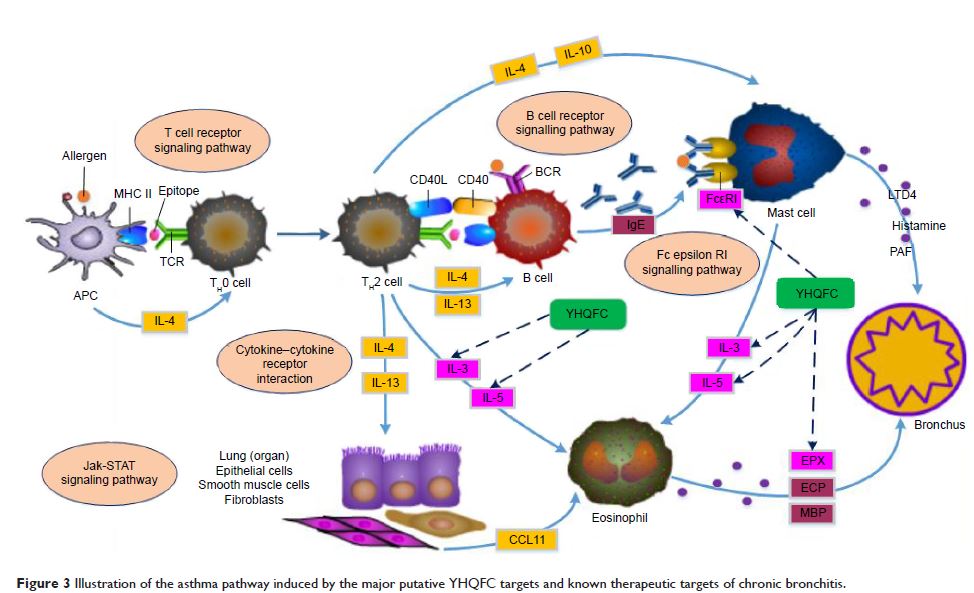9 5 7 4 9
论文已发表
注册即可获取德孚的最新动态
IF 收录期刊
- 3.3 Breast Cancer (Dove Med Press)
- 3.4 Clin Epidemiol
- 2.5 Cancer Manag Res
- 2.9 Infect Drug Resist
- 3.5 Clin Interv Aging
- 4.7 Drug Des Dev Ther
- 2.7 Int J Chronic Obstr
- 6.6 Int J Nanomed
- 2.5 Int J Women's Health
- 2.5 Neuropsych Dis Treat
- 2.7 OncoTargets Ther
- 2.0 Patient Prefer Adher
- 2.3 Ther Clin Risk Manag
- 2.5 J Pain Res
- 2.8 Diabet Metab Synd Ob
- 2.8 Psychol Res Behav Ma
- 3.0 Nat Sci Sleep
- 1.8 Pharmgenomics Pers Med
- 2.7 Risk Manag Healthc Policy
- 4.2 J Inflamm Res
- 2.1 Int J Gen Med
- 4.2 J Hepatocell Carcinoma
- 3.7 J Asthma Allergy
- 1.9 Clin Cosmet Investig Dermatol
- 2.7 J Multidiscip Healthc

在网络药理学基础上确定银黄清肺 (Yin-Huang-Qing-Fei) 胶囊作用于慢性支气管炎的关键药理学途径
Authors Yu GH, Zhang YQ, Ren WQ, Dong L, Li JF, Geng Y, Zhang Y, Li DF, Xu HY, Yang HJ
Received 30 August 2016
Accepted for publication 9 November 2016
Published 22 December 2016 Volume 2017:12 Pages 85—94
DOI https://doi.org/10.2147/COPD.S121079
Checked for plagiarism Yes
Review by Single-blind
Peer reviewers approved by Dr Amy Norman
Peer reviewer comments 2
Editor who approved publication: Dr Richard Russell
Abstract: For decades in China, the Yin–Huang–Qing–Fei capsule (YHQFC) has been
widely used in the treatment of chronic bronchitis, with good curative effects.
Owing to the complexity of traditional Chinese herbal formulas, the
pharmacological mechanism of YHQFC remains unclear. To address this problem, a
network pharmacology-based strategy was proposed in this study. At first, the
putative target profile of YHQFC was predicted using MedChem Studio, based on
structural and functional similarities of all available YHQFC components to the
known drugs obtained from the DrugBank database. Then, an interaction network
was constructed using links between putative YHQFC targets and known
therapeutic targets of chronic bronchitis. Following the calculation of four
topological features (degree, betweenness, closeness, and coreness) of each
node in the network, 475 major putative targets of YHQFC and their topological
importance were identified. In addition, a pathway enrichment analysis based on
the Kyoto Encyclopedia of Genes and Genomes pathway database indicated that the
major putative targets of YHQFC are significantly associated with various
pathways involved in anti-inflammation processes, immune responses, and
pathological changes caused by asthma. More interestingly, eight major putative
targets of YHQFC (interleukin [IL]-3, IL-4, IL-5, IL-10, IL-13, FCER1G, CCL11,
and EPX) were demonstrated to be associated with the inflammatory process that
occurs during the progression of asthma. Finally, a molecular docking
simulation was performed and the results exhibited that 17 pairs of chemical
components and candidate YHQFC targets involved in asthma pathway had strong
binding efficiencies. In conclusion, this network pharmacology-based
investigation revealed that YHQFC may attenuate the inflammatory reaction of
chronic bronchitis by regulating its candidate targets, which may be implicated
in the major pathological processes of the asthma pathway.
Keywords: traditional Chinese medicine, Yin–Huang–Qing–Fei capsule, chronic
bronchitis, network pharmacology, asthma pathway
